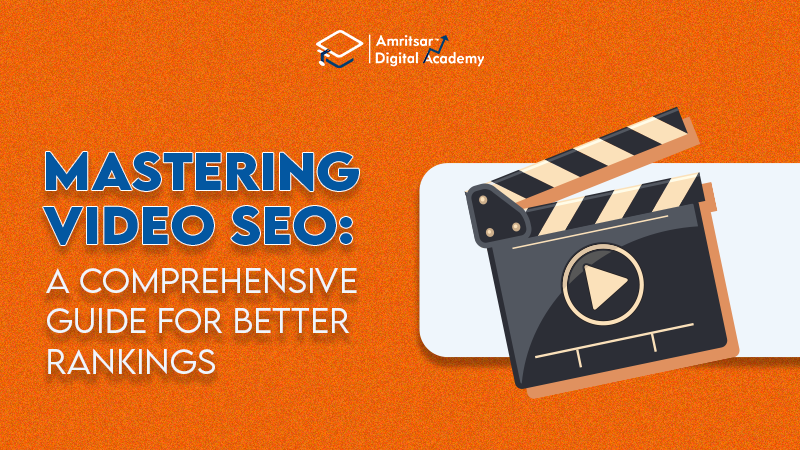Video is king in our current era. It draws in viewers, increases brand recognition, and encourages profitable conversions. However, producing high-quality video material alone is insufficient. Experts in digital marketing and SEO must become proficient in video SEO to succeed in the current digital environment.
Having your videos at the top of Google’s video search results or even the regular web search results can drive massive traffic to your site. However, ranking videos can be tricky if you don’t know the right video SEO techniques
Having Video on Your Website: An Improved Performance Indicator for Google Search
- It increases your website’s core SEO key performance indicators: You’ve got great video content on your website, and your target market is looking for that content to answer their questions. They can find your content, and if your content satisfactorily answers their questions, they’re more likely to visit your website (increased traffic), stay on your website (decreased bounce rate), and spend longer periods on your website (increased dwell time). Since dwell time is also a major ranking factor for search engines, those improved performance metrics fuel your rankings.
- Video results in SERPs increase click-through rates: SERP listings with an associated video and thumbnail are much more attractive than text-based listings, and there’s data to prove that they’re also more effective. SERP results with video links drive a 157% increase in organic traffic, and landing pages with a video on them are 53% more likely to show up on a SERP. That means having video on your website makes it both more likely that users will see it in their search engine results, and also more likely that they’ll click through and watch your content.
- Video can lower bounce rates: Nowadays, most of people prefer to learn through videos rather than text. Even the reports have shown that in the past few years, videos have gained more importance than any other form of content. People find video more engaging and they are likely to stay more on video pages which means it lowers the bounce rate.
- Great videos earn backlinks: Backlinks are hugely important to a high-performing video SEO strategy. Choosing to promote and endorse someone else’s content is the highest honor one website can give to another, and Google recognizes that as an important factor when ranking content.
- Video SEO reinforces keyword strategies: By now you’ve likely got an existing keyword strategy in place, and video can easily supplement that approach. Whether you’re hosting your video on your website or an alternate platform.
Videos on your Website vs. a Video Platform
| Factor | Hosting Videos on Your Website | Video Platform |
| Control | You have full control over video content, customization, and presentation on your site. | Limited control over customization; platform’s layout and features dictate presentation. |
| Customization | You can design video players to align with your site’s aesthetics and branding. | Limited customization options based on platform templates. |
| Hosting Costs | Costs associated with hosting and serving videos on your website, depending on bandwidth usage. | Often free for basic usage, with premium plans offering additional features at varying costs. |
| Technical Maintenance | The platform handles technical aspects like updates, security, and maintenance. | Robust analytics provide detailed insights into viewer behavior, engagement, and demographics. |
| Loading Speed | Responsible for video maintenance, including updates, security, and troubleshooting. | Responsible for video maintenance, including updates, security, and troubleshooting. |
| Analytics & Insights | Limited analytics unless integrated with third-party tools; basic view counts might be available. | Videos hosted on platforms may contribute indirectly to SEO, but the direct impact is on the platform’s domain, not your site. |
| Monetization | Direct control over monetization strategies, like ad placement or paid access to videos. | Platform-specific monetization models (ads, subscriptions, etc.) with revenue sharing in some cases |
| SEO Impact | Can contribute to on-site SEO if optimized properly; may impact site loading speed. | Videos hosted on platforms may contribute indirectly to SEO, but direct impact is on the platform’s domain, not your site. |
| Sharing & Discoverability | Relies on your website’s traffic and sharing; limited discoverability beyond your audience. | The platform handles technical aspects like updates, security, and maintenance. |
Optimizing Your Videos to Afford the Best Search on Google: Best Practices
Optimize Video Titles and Descriptions
The title and description you give your video are critical for helping search engines understand the topic of the content. Include your target keyword phrases in the title if possible. Write clear, descriptive titles and descriptions that would make sense to users searching for that topic.
Add Captions and Transcripts
Transcripts allow search engines like Google to read the text content inside your videos. Having transcripts can boost a video’s rankings substantially compared to videos without text content. Add captions or subtitles while editing and provide a full-text transcript on your video’s landing page.
Use Relevant Tags and Categories
Tagging your videos appropriately is key. Include tags that are relevant to the video topic and would be used by someone searching for that keyword or phrase. Properly categorizing videos also helps YouTube suggest them for related queries.
Embed Videos on Website Pages
Hosting videos directly on your website and embedding them on topic-relevant pages can improve their rankings, as opposed to only having them live on YouTube. Search engines give preference to videos that are embedded on web pages with supporting text and backlinks. Google can more easily identify a video on your page when there’s an HTML tag around it, for example: <video>, <embed>, <iframe>, or <object>.
Generate Backlinks to Your Videos
Backlinks help search engines determine relevance and authority for ranking purposes. Build backlinks to your videos from related websites by promoting your content and getting others to embed or link back to your videos.
Create a separate page for each video
These dedicated pages provide comprehensive context, including detailed descriptions, relevant metadata, and supplementary resources that enrich the understanding and engagement with the content. They foster a direct connection between the audience and the video, allowing for specific discussions, and interaction through comments or related content suggestions, and enabling precise tracking of viewership and analytics for each video asset.
Promote Your Videos
Leverage social media and email marketing to promote your videos widely. More social shares and engagement signals will help the video rank better in search and YouTube. Promote videos in relevant online communities as well.
Optimize Video Watch Time
Videos that hold viewer attention and have higher average watch times tend to rank higher in search results. Create engaging content optimized for length to reduce drop-offs and improve watch metrics.
Video Availability on the Public Web
Make sure that each video is available on a public web page where users can watch the video. Make sure that the page isn’t blocked by robot.txt or no-index robots meta tag; this ensures that Google can find and index your page.
Third-Party Embedded Players
If your website embeds videos from third-party platforms like YouTube, Vimeo, or Facebook, Google may index the video both on your web page and on the equivalent page from the third-party hosting site. As a result, both versions may appear in video features on Google. Therefore, for your page where you’ve embedded the third-party player, we still recommend that you provide structured data. Additionally, you may also include these pages in your video sitemap. Furthermore, check with your video host to ensure they allow Google to fetch your video file; for example, this is supported by YouTube for public videos.
Provide a high-quality video thumbnail
To be eligible to appear in Google video features, a video must have a valid thumbnail image. Otherwise, the page may be indexed but would only appear as a text result. You can allow Google to generate a thumbnail, or provide one in one of the supported ways:
● If you’re using the <video> HTML tag, specify the poster attribute.
● In a video sitemap, specify the <video:thumbnail_loc> tag.
● In structured data, specify the thumbnailUrl property.
● If you allow Google to fetch your video content files, Google can generate a thumbnail for you. Supported thumbnail formats: BMP, GIF, JPEG, PNG, WebP, and SVG.Size: Minimum 60×30 pixels, larger preferred.
Provide structured data
Provide structured data describing your video, to help Google understand what the video is about and surface it for relevant queries. Ensure that any information that you provide in structured data is consistent with the actual video content. When adding structured data, make sure to use unique thumbnails, titles, and descriptions for each video on your site. You should provide the same title, thumbnail URL, and video URL in all sources (sitemap, HTML tags, meta tags, and structured data) that describe the same video on the same page.
FAQ
Ques1: How can I optimize my video title for search?
Ans: Choose a title that includes your main keyword phrase, makes the topic clear to viewers, and is compelling to get clicks. Keep titles under 60 characters if possible.
Ques2: What is the ideal length for ranking videos?
Ans: Typically videos between 2-5 minutes tend to perform best in search results. Very short videos (under 1 minute) or very long videos (over 10 minutes) may rank lower unless the content is exceptional.)
Ques 3: Should I use a video transcription service?
Ans: Yes, transcripts are very helpful for video SEO. Transcripts allow search engines to read your video content. You can use a service to create automated transcripts or upload your own.
Ques 4: How important are tags and metadata?
Ans: Proper tags, categories, and description metadata provide critical information to search engines about your video topic and focus. Use relevant keywords and natural language – don’t keyword stuff.




